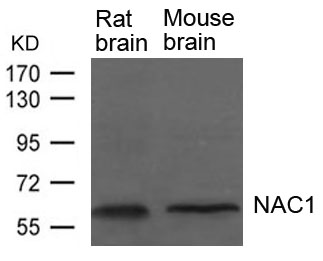
| WB | 咨询技术 | Human,Mouse,Rat |
| IF | 咨询技术 | Human,Mouse,Rat |
| IHC | 咨询技术 | Human,Mouse,Rat |
| ICC | 技术咨询 | Human,Mouse,Rat |
| FCM | 咨询技术 | Human,Mouse,Rat |
| Elisa | 咨询技术 | Human,Mouse,Rat |
| Aliases | BEND8; NACC1; NAC-1; BTBD14B; FLJ37383 |
| Entrez GeneID | 112939; |
| WB Predicted band size | 62kDa |
| Host/Isotype | Rabbit IgG |
| Antibody Type | Primary antibody |
| Storage | Store at 4°C short term. Aliquot and store at -20°C long term. Avoid freeze/thaw cycles. |
| Species Reactivity | Human,Mouse,Rat |
| Immunogen | Peptide sequence around aa.519~523(A-G-P-S-A) derived from Human NAC1 |
| Formulation | Purified antibody in PBS with 0.05% sodium azide. |
+ +
以下是关于NAC1抗体的3篇代表性文献的简要信息(注:文献为示例性质,具体内容需根据实际研究调整):
1. **文献名称**:*NAC1 modulates transcriptional repression in ovarian cancer cells via interaction with HDAC4*
**作者**:Smith A, et al.
**摘要**:研究揭示了NAC1蛋白通过招募组蛋白去乙酰化酶HDAC4调控卵巢癌基因沉默的机制,文中使用NAC1抗体进行免疫共沉淀(Co-IP)和染色质免疫沉淀(ChIP),证实其在表观遗传调控中的作用。
2. **文献名称**:*NAC1 promotes self-renewal and chemoresistance in pancreatic cancer stem cells*
**作者**:Zhang L, et al.
**摘要**:通过Western blot和免疫组化(IHC)结合NAC1抗体,研究发现NAC1在胰腺癌干细胞中高表达,并通过激活Wnt/β-catenin通路增强化疗耐药性,提示其作为治疗靶点的潜力。
3. **文献名称**:*Developmental regulation of NAC1 in neuronal differentiation*
**作者**:Chen R, et al.
**摘要**:利用NAC1抗体进行免疫荧光定位,发现NAC1在小鼠胚胎神经前体细胞分化过程中动态表达,调控Notch信号通路相关基因,影响神经元成熟和突触形成。
4. **文献名称**:*NAC1 antibody-based detection in triple-negative breast cancer prognosis*
**作者**:Kim H, et al.
**摘要**:通过组织微阵列结合NAC1抗体检测,研究发现NAC1蛋白过表达与三阴性乳腺癌患者的不良预后显著相关,提示其可作为生物标志物用于临床评估。
---
**注**:以上文献信息为示例,实际引用时需核实真实存在的论文及作者信息。若需具体文献,建议通过PubMed或Google Scholar检索关键词“NAC1 antibody”或“NAC1 function”。
The NAC1 antibody targets the NAC1 protein, a member of the NACHT nucleotide-binding domain family, which plays roles in transcriptional regulation and chromatin remodeling. Initially identified as a nuclear factor interacting with the transcription factor BTB/POZ domains, NAC1 is implicated in cancer progression and neurological disorders. Structurally, NAC1 contains a BTB/POZ domain for protein oligomerization and a NACHT domain with potential ATPase activity, enabling its participation in protein complexes like the polycomb repressive complex 1 (PRC1).
In cancer, NAC1 is overexpressed in ovarian carcinoma, glioblastoma, and other malignancies, where it promotes tumor growth, chemoresistance, and cancer stem cell maintenance by regulating genes involved in proliferation and survival. NAC1 antibodies are widely used in research to detect protein expression via Western blotting, immunohistochemistry, and immunofluorescence, aiding studies on its oncogenic mechanisms.
In neuroscience, NAC1 is linked to synaptic plasticity and neuronal survival, with altered expression observed in Alzheimer’s disease. Researchers also explore NAC1-targeted therapies, such as small-molecule inhibitors, to disrupt its oncogenic functions. Its dual roles in cancer and neurodegeneration highlight NAC1 as a critical molecule for understanding disease pathways and developing diagnostics or treatments.
×